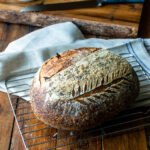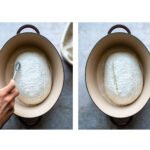
- 50 g sourdough starter (about ¼ cup)
- 100 g filtered water 80°F (3½ ounces OR scant ½ cup)
- 50 g whole wheat bread flour (1¾ ounces OR roughly ⅓ cup)
- 50 g white bread flour (1¾ ounces OR roughly ⅓ cup)
- 100 g leaven (generous ½ cup)
- 350 g filtered water, divided 80°F, divided (12¼ ounces OR 1½ cups + 1 Tbsp)
- 450 g bread flour (15¾ ounces OR roughly 3 cups)
- 50 g whole wheat bread flour (1¾ ounces OR roughly ⅓ cup)
- 10 g salt (1¾ teaspoons)
-
Start by making your leaven. Combine the sourdough starter, water and flours in a jar or bowl. Stir well, cover loosely and then let the leaven sit in a 70ºF environment until it has doubled in bulk and a small piece of it will float in water. This could be as little as 6 hours, or overnight.
-
When the leaven is ready, combine 100g of the leaven with 325g of water and both flours. Stir together with a wooden spoon or your hands until there is no trace of dry flour left. Cover the bowl and let it sit for 30 to 40 minutes.
-
Mix the salt with the remaining 25g of water. Stir to dissolve the salt a little, but don't worry if it doesn't all dissolve. Pour the salt and water over the dough and squeeze the dough through your fingers until the water has been absorbed. Continue to work the dough until it becomes a little more uniform. Pull the far side of the dough into the center on top, rotate the dough and pull the side of the dough into the center again. Do this all around the dough until it becomes a uniform ball. Transfer the dough to the bowl where it will sit to rise - a large bowl or a clear plastic container. Cover the bowl with plastic wrap or put a lid on the container. Let the dough rest for 30 minutes.
-
While the dough is rising, give it a "turn" every 30 minutes. Grab one side of the dough and folding it over on itself. Then, turn the container or bowl 90º and fold it again. Fold all four edges of the dough this way and you've completed one "turn". As the dough rises, it will change in texture, becoming lighter and airier. When it is lighter and airier, "turn" the dough more gently - picking it up in the middle and letting the ends fold under the dough instead of folding the dough onto itself. The rising time should take 4 to 6 hours, with "turns" every 30 minutes. The dough is ready for the shaping stage when it has turned into a smoother, lighter dough. With time, you'll be able to recognize this change in the dough. If you're in doubt, let the dough rise for 4 hours and then proceed to the next step.

-
Turn the dough out onto a floured surface. Gather the outer edges of the dough up to the center and then turn the dough over so the floured side is up. Use a board scraper to pull the dough towards you, tightening the top of the dough and tucking the bottom of the dough under itself. This shouldn't take too long - a couple of pulls towards you. Let the dough rest for 30 minutes.

-
For the final shaping, flour the top of the rested dough and then turn it over on your counter so the floured side is down. Grab the bottom edge of the dough closest to you and fold it up towards the middle of the dough. Pull one side of the dough out and fold it in towards the center. Do the same with the opposite side. Then, grab the top side of the dough farthest from you and fold it down to the center. Flip the dough over and use your board scraper again to pull the dough towards you to tighten the top and tuck in the bottom of the dough. Transfer the dough to a banneton or proofing basket, dusted with fine cornmeal, rice flour or a floured tea towel. Cover the dough with a plastic bag and place it in the refrigerator overnight.

-
In the morning, remove the dough from the refrigerator and pre-heat your oven to 500ºF with a lidded cast iron pot inside. This should take 30 minutes. When the oven and pot have pre-heated, remove the pot from the oven and remove the lid. Carefully invert the dough into the pot. Use a sharp knife or a baker's lame to slash the dough, making whatever design you like. Cover the pot with the hot lid and return the pot to the oven.

-
Lower the temperature of the oven to 450ºF and let the bread bake, covered for 20 minutes. Remove the lid and continue to bake at 450ºF for another 20 minutes or until the bread has browned significantly.
-
Remove the bread from the oven and let it sit for a few minutes in the pot before letting it cool completely on a cooling rack.